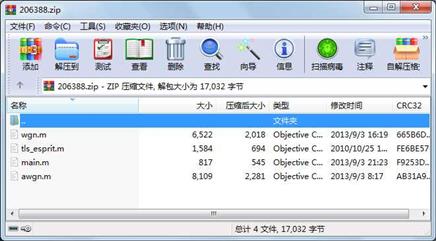资源简介
基于子空间的旋转不变算法ESPRIT,可估计输入信号的到达角、离开角

代码片段和文件信息
function y=awgn(varargin)
%AWGN Add white Gaussian noise to a signal.
% Y = AWGN(XSNR) adds white Gaussian noise to X. The SNR is in dB.
% The power of X is assumed to be 0 dBW. If X is complex then
% AWGN adds complex noise.
%
% Y = AWGN(XSNRSIGPOWER) when SIGPOWER is numeric it represents
% the signal power in dBW. When SIGPOWER is ‘measured‘ AWGN measures
% the signal power before adding noise.
%
% Y = AWGN(XSNRSIGPOWERS) uses S which is a random stream handle to
% generate random noise samples with RANDN. If S is an integer then
% resets the state of RANDN to S. The latter usage is obsoleted and may
% be removed in a future release. If you want to generate repeateable
% noise samples then provide the handle of a random stream or use reset
% method on the default random stream. Type ‘help RandStream‘ for more
% information.
%
% Y = AWGN(XSNRSIGPOWERSTATE) resets the state of RANDN to STATE.
% This usage is deprecated and may be removed in a future release.
%
% Y = AWGN(... POWERTYPE) specifies the units of SNR and SIGPOWER.
% POWERTYPE can be ‘db‘ or ‘linear‘. If POWERTYPE is ‘db‘ then SNR
% is measured in dB and SIGPOWER is measured in dBW. If POWERTYPE is
% ‘linear‘ then SNR is measured as a ratio and SIGPOWER is measured
% in Watts.
%
% Example 1:
% % To specify the power of X to be 0 dBW and add noise to produce
% % an SNR of 10dB use:
% X = sqrt(2)*sin(0:pi/8:6*pi);
% Y = awgn(X100);
%
% Example 2:
% % To specify the power of X to be 3 Watts and add noise to
% % produce a linear SNR of 4 use:
% X = sqrt(2)*sin(0:pi/8:6*pi);
% Y = awgn(X43‘linear‘);
%
% Example 3:
% % To cause AWGN to measure the power of X and add noise to
% % produce a linear SNR of 4 use:
% X = sqrt(2)*sin(0:pi/8:6*pi);
% Y = awgn(X4‘measured‘‘linear‘);
%
% Example 4:
% % To specify the power of X to be 0 dBW add noise to produce
% % an SNR of 10dB and utilize a local random stream use:
% S = RandStream(‘mt19937ar‘‘seed‘5489);
% X = sqrt(2)*sin(0:pi/8:6*pi);
% Y = awgn(X100S);
%
% Example 5:
% % To specify the power of X to be 0 dBW add noise to produce
% % an SNR of 10dB and produce reproducible results use:
% reset(RandStream.getDefaultStream)
% X = sqrt(2)*sin(0:pi/8:6*pi);
% Y = awgn(X100S);
%
%
% See also WGN RANDN RandStream/RANDN and BSC.
% Copyright 1996-2008 The MathWorks Inc.
% $Revision: 1.9.4.7 $ $Date: 2009/01/05 17:45:01 $
% --- Initial checks
error(nargchk(25nargin‘struct‘));
% --- Value set indicators (used for the string flags)
pModeSet = 0;
measModeSet = 0;
% --- Set default values
sigPower = 0;
pMode = ‘db‘;
measMode = ‘specify‘;
state = [];
% --- Placeholder for the signature string
sigSt属性 大小 日期 时间 名称
----------- --------- ---------- ----- ----
文件 817 2013-09-03 21:23 main.m
文件 1584 2010-10-25 11:20 tls_esprit.m
文件 6522 2013-09-03 16:19 wgn.m
文件 8109 2013-09-03 08:17 awgn.m
- 上一篇:多重信号分类MUSIC 算法
- 下一篇:富士康EHS管理体系
相关资源
- 信号估计DOAmusicespritcapon
- 现代谱估计算法 music ESPRIT 谐波分解
- UWB中基于TDOA定位方法的Fang算法论文参
- OA企业协同办公系统建设方案
- 非均匀阵列+MUSIC算法 DOA仿真代码
- Advances in Direction-of-Arrival Estimation 绝对
- oA办公系统源码MyOffice
- UWB的TDOA无线同步官方实现笔记.rar
- Classical and Modern Direction-of-Arrival Esti
- ESPRIT算法及估计性能误差分析
- Chan氏 定位算法原理公式详细推导
- TDOA定位系统
- UWB TDOA无线同步官方实现笔记-中文版
- 签名工具DOAPK,diy自己的rom
- UWB_TDOA.rar
- 计算机等级考试AOA试题
- a mind for numbers - barbaraoakley学习之道英
- 空间谱估计理论与算法.pdf——王永良
- Elcomsoft.Advanced.PDF.Password.Recovery.v5.0.
- music算法esprit算法
- DOA估计算法性能分析
- 考虑锚点位置误差的井下TDOA改进算法
- TDOA的凸优化.zip
- ESPRIT波达角估计
- DOA估计的MUSIC算法改进
- AoA室内定位技术简介
- 压缩感知CS的DOA代码
- flash avm2 虚拟机说明
- CHAN、Taylor、AOA等基本定位算法
- tct-doa估计
 川公网安备 51152502000135号
川公网安备 51152502000135号
评论
共有 条评论